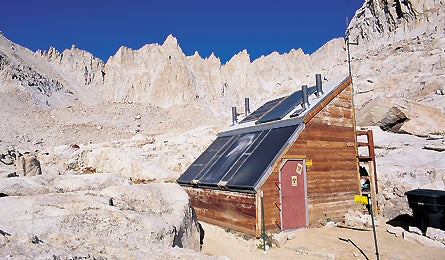Packing Out Waste: You Can Take It With You

'In 2007, rangers removed the last toilets from Mt. Whitney. (Laurence Parent)'
Ryan Zondervan wasn’t pleased when a ranger handed him a WAG bag along with his group’s permit to climb Mt. Whitney last summer, but he also wasn’t surprised. He’d heard about the new rules asking hikers to carry out their poop along with their food waste and energy bar wrappers. Zondervan used his WAG Bag at Whitney’s Trail Camp, at 12,000 feet, where a privy stood until last season. After reaching the summit, he picked up the bag on his descent and carried it more than six miles to the trailhead, where he dropped it in a trash can–his small contribution to the more than three tons of waste hauled off the mountain in 2007. “The convenience issue is definitely a big thumbs-down, but I understand the need for measures like this,” says Zondervan, a Seattle resident.
Packing out personal waste is not a new concept. Climbers on Mt. Rainier started using “blue bags” in the early 1980s, and mandatory carry-everything-out programs later spread to popular peaks like Shasta and Denali, as well as to environmentally sensitive Utah canyons like Buckskin Gulch and the Virgin River Narrows. But the addition of Mt. Whitney to that list signals a new willingness by land managers to use this tactic on trails where backcountry toilets are impractical to build, and the routes are too trafficked or rocky to absorb the impact of numerous cat holes. Starting this summer, the thousands of Grand Teton National Park visitors who cross Jenny Lake to reach popular Cascade Canyon will have free access to bags. And Hawaii Volcanoes National Park soon will hand out waste bags with hiking permits for Mauna Loa.
Rocky Mountain National Park, which began a pilot waste-bag program aimed at rock climbers last summer, now plans to give them to anyone buying a backcountry camping permit. “We’ll tell people there are privies out there, but this is something we’re experimenting with,” says Jim Dougan, the park’s wilderness program specialist. “We’re trying to get people to think of popular trails the same way they think of well-used river corridors; everything you bring into the backcountry needs to return with you.”
How does it work? The two leading products are WAG and Restop 2 bags; both neutralize waste with gelling compounds that absorb moisture (and stink) when you deposit your urine or feces inside. They come with toilet paper and hand sanitizer, and used bags can be dropped in any trash container or landfill. If this innovation sounds unappealing, don’t be alarmed. Most agencies are taking a go-slow approach as officials determine if the disposal bags cause unexpected problems (like people discarding them on the trail), and whether the results are environmentally better than the traditional LNT practice of burying waste. Packing it all out remains voluntary in most parks, but if you’re looking for the ultimate in low-impact hiking, there’s no better way to leave nothing but footprints.